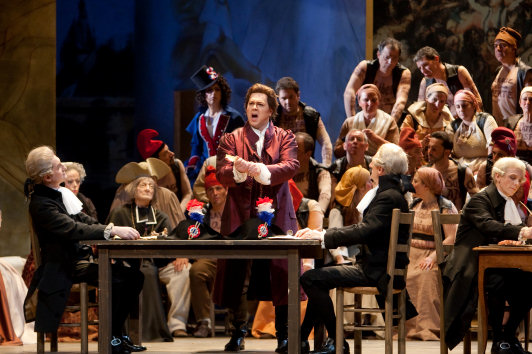Other Links
Editorial Board
-
Editor - Bill Kenny
-
Deputy Editor - Bob Briggs
Founder - Len Mullenger
Google Site Search
SEEN AND HEARD
INTERNATIONAL OPERA REVIEW
Giordano, Andrea Chenier:
Soloists,
Orchestre National du Capitole, Choeur du Capitole, Conductor:
Pinchas Steinberg, Théâtre du Capitole de Toulouse 30.01.2009 (JMI)
Production Opera National de Lorraine
Director: Jean-Louis Martinoty
Sets: Bernard Arnould
Costumes: Daniel Ogier
Lighting: Jean-Philippe Roy
Cast:
Andrea Chenier: Robert Dean Smith
Maddalena: Irene Cerboncini
Carlo
Gerard: Sergey Murzaev
Contesa: Stefania Toczyska
Bersi: Varduhi Abrahamyan
L’Incredibile: Emiliano González-Toro

This production from Nancy was premiered in March of last year. The
stage direction was by Jean-Louis Martinoty, for so many years a
regular collaborator with the much admired Jean Pierre Ponnelle.
Martinoty’s production is historically authentic, using his
knowledge of the French Revolution to further inform Luigi Illica’s
libretto. He says in the programme that to transpose the action to
any other revolution would not make sense, so precise is Illica in
the libretto. Martinoty’s knowledge is profound – something we are
little used to in the work of his colleagues!
The stage sets are based on movable painted panels, the movement of
which allowed the stage to open and close, producing the atmosphere
demanded by the action. Use was made of great paintings of the same
epoch, for example, Watteau (the small theatre playing “O,
pastorelle addio”), Goya (the choir entering the mansion with
Gerard leading them “sua gradezza, la miseria) and David
with Le Serment du Jeu de Paume, during Act III. The costumes
were very nicely detailed, and a suitable lighting plot completed
the production. Stage direction of the group scenes was very good,
whereas direction of individual actors left something to be
desired. There were some superfluous details such as the pantomime
that takes place on stage before the opera starts.
Pinchas Steinberg is one of the conductors most frequently to be
found at the Toulouse Capitole, and consequently knows the
orchestra well and gets a great response from them. In my many years
attending the Capitole it is the first time that I have seen him
conducting Italian opera here, although he has often conducted this
repertoire in other theatres. (Without going too far back, Mr.
Steinberg conducted the Liceu’s Andrea Chenier two years
ago). He and the orchestra delivered a reading of the score which
was full of life, and for me this was the best part of the evening.
Almost everybody would agree that this opera needs a trio of very
strong voices, and in particular a first class tenor with the sort
of voice that is all too rare at the moment. Nicolas Joel, already
20 years at the helm of the theatre, has always given a great
importance to voices and he writes in the theatre magazine that he
decided to programme Andrea Chenier because he believed he
had an exceptional tenor for the title role. Sadly, I am not
convinced that the cast he has actually offered is up to what one
has come to expect from Mr Joel.
Robert Dean Smith is one of the more frequently encountered tenors
in the Wagnerian lyric repertoire during the last few years and he
is also a regular performer in Strauss operas. However, to find him
in Italian opera is quite unusual. To combine Tristan – a role I
believe to be too heavy for him - and Andrea Chenier or Des Grieux (Manon
Lescaut) is not an easy task and comes as something of a
surprise. If you review his performances over the last two years you
will not find any Italian opera, although I believe his voice is,
or better was, well suited to this type of opera, offering
a timbre with more beauty than power. His performance as the poet
Chenier had moments of doubtless quality, specially the aria “Como
un bel dì di Maggio”, whereas the Improvisso was not
particularly brilliant, improving in “Si, fui soldato”. In
general, he is short of “squillo” in the high register. He
was not an impassioned protagonist, being rather cold at many
moments. All in all, he was a good Chenier, but this is a role that
probably comes to him too late in his career.
Italian soprano Irene Cerboncini was not an extraordinary Maddalena
di Coigny. The voice does not offer too much quality, although it is
well suited to the demands of the role. However, her singing is too
monotonous and as she is not a great actress either the result was
another cold performance. Neither of the love duets with Chenier
were very convincing.
Carlo Gerard is a character who demands a Verdi baritone, needing
power, but with the additional requirement that he must sing with
nobility at moments if he is to display the special complexity of
this character. The Russian baritone Sergey Murzaev has more than
enough voice for the part, but is short in nobility, expressiveness
and intention. He sang everything forte and this is not
worthy of a great Gerard. This, however, did not seem to worry the
audience, proving once again that audiences want to hear voices, big
voices.
In the secondary roles we had the veteran Polish mezzosoprano
Stefania Toczyska, who still has an acceptable voice. Maria Jose
Montiel made a good Madelon. The Armenian Varduhi Abrahamyan was a
Bersi without pain or glory. Emiliano González-Toro doubled as Abate
and L'Incredibile and he was good.
There was a full house. At the final bows, most applause went to Murzaev,
although there was also appreciation shown for Dean Smith,
Cerboncini and Pinchas Steinberg.
Jose M Irurzun
Picture © Patrice Nin
Back
to Top
Cumulative Index Page
